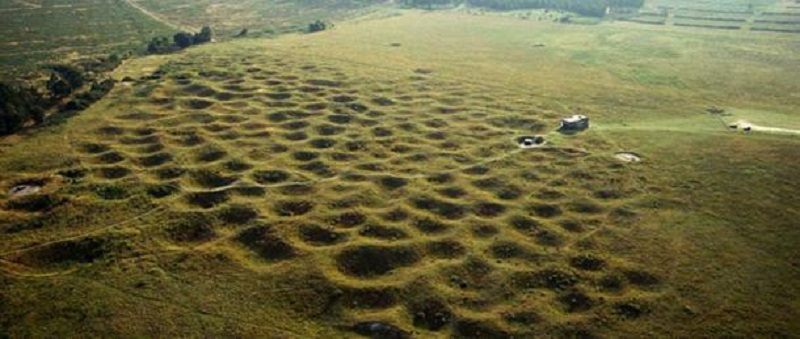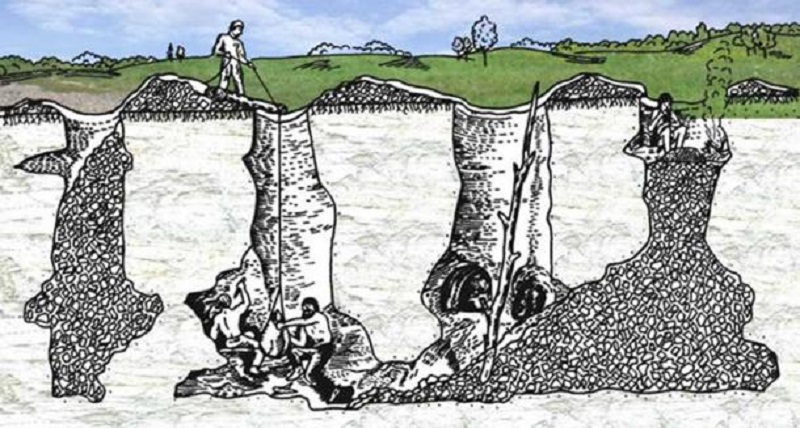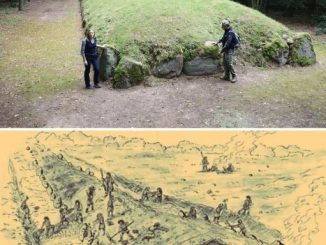Grime’s Graves is a spectacular Neolithic flint mining site located near Thetford Forest, Norfolk, East England. Beginning around 5,000 years ago and continuing over the course of a millennium, Stone Age peoples mined flint ‘floorstone’ below more than 10 meters of chalk. They used only deer antlers to create more than 400 axes. Once they completed a tunnel, they filled it back in, leaving the cratered landscape we see today.
Knowledge of the flint quarried from the site was lost for some time after the Neolithic period, and it was only in the second half of the 19th century that the original function of Grime’s Graves was rediscovered.
The first thing one might notice about Grime’s Graves is probably its name. While flint was quarried in this area by people living during the Neolithic period, its current name was only given at a much later age. According to some sources, this area was once identified as the Devil’s resting place. According to other sources, the site was associated by the Anglo-Saxons with Grim, a chthonic god in their pantheon (sometimes identified as Woden). The name given to the site by the Anglo-Saxons can be translated as ‘Grim’s quarry’, an indication that they may have been aware of flint quarries.
The landscape of Grime’s Graves can be described as somewhat eerie. Looking at aerial photos of the area, one can see a grassy landscape covered with holes. It is estimated that there are about 400 such pits scattered over an area of 90 acres. Incidentally, these holes are sometimes called ‘Devil’s Holes’. This strange landscape has been interpreted in many different ways by British antiquarians. For example, the famous Elizabethan antiquarian, William Camden, suggested that the site included ‘small trenches and ancient fortifications’, while the 18th-century antiquarian, Francis Blomefield (who from Norfolk), believed the holes were ‘Danish campsites’.
An aerial view of Grime’s Graves. Photo source: English Heritage.
Only in the 19th century were these pits excavated. The first excavations occurred in 1852, when two of the pits were dug by Reverend Pettigrew, while several others were opened by Reverend Manning. Several more pits were excavated by the latter upon his return in 1866. However, these early excavations were not well documented and were not of much use.
It was in 1868 that Canon William Greenwell began his excavations at Grime’s Graves. The process lasted two years and the results were more important than those of Pettigrew and Manning. Among other things, Greenwell discovered red deer antlers (the main mining tool) and a stone ax made of Cornish greenstone. In the gallery where the ax was discovered, impact marks made by the tool’s blade on the chalk walls were also found.
An illustration of ancient flint mining (miningfocus.org)
From the tools found, Greenwell deduced that they belonged to the Neolithic period. From there, the scriptures were able to prove that flint mines existed since prehistoric times. It was the first time such a cold protest had been carried out anywhere in the UK. However, Greenwell’s discovery was not without controversy, as there are those who argue that flint mining was carried out during the Paleolithic period.
One of the galleries, radiating from the bottom of the 9m shaft, has artificial lighting. Viewing direction (NE) is approximate. ( CC by SA 2.0 / Ian Taylor )
Many other pits have been excavated over the decades, including Pit 15, arguably the most controversial pit at the site. The pit was excavated from 1937 to 1939 by Leslie Armstrong, an archaeologist hoping to prove that flint mining dates back to the Paleolithic period. One of the artifacts found by Armstrong during his excavations was a small carved statue known as the ‘chalk goddess’. Although the statue is said to look similar to other statues known from the Paleolithic period, its discovery has been met with skepticism. The authenticity of this statue has been questioned and it has been suggested that it was deliberately placed there by someone during Armstrong’s excavations.
Further archaeological work was carried out at Grime’s Grave’s during the 1970s, including one carried out by the British Museum between 1974 and 1976, re-excavating the Greenwell pit. To date, at least 28 pits have been excavated, providing archaeologists with information not only about how these mines were used during the Neolithic period but also what happened to them afterward.




